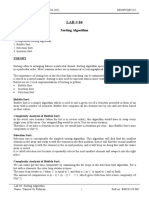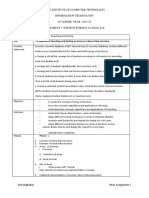0% found this document useful (0 votes)
8 views2 pagesLAB TASK (Array2)
The document outlines tasks for implementing searching and sorting algorithms, including linear search, binary search, bubble sort, selection sort, and insertion sort. It also includes performance analysis through test cases and documentation requirements summarizing implementation, test results, and efficiency observations. Submission requires source code and a report on findings, with an emphasis on good programming practices.
Uploaded by
haleemasadia0024Copyright
© © All Rights Reserved
We take content rights seriously. If you suspect this is your content, claim it here.
Available Formats
Download as DOCX, PDF, TXT or read online on Scribd
0% found this document useful (0 votes)
8 views2 pagesLAB TASK (Array2)
The document outlines tasks for implementing searching and sorting algorithms, including linear search, binary search, bubble sort, selection sort, and insertion sort. It also includes performance analysis through test cases and documentation requirements summarizing implementation, test results, and efficiency observations. Submission requires source code and a report on findings, with an emphasis on good programming practices.
Uploaded by
haleemasadia0024Copyright
© © All Rights Reserved
We take content rights seriously. If you suspect this is your content, claim it here.
Available Formats
Download as DOCX, PDF, TXT or read online on Scribd
/ 2


























































